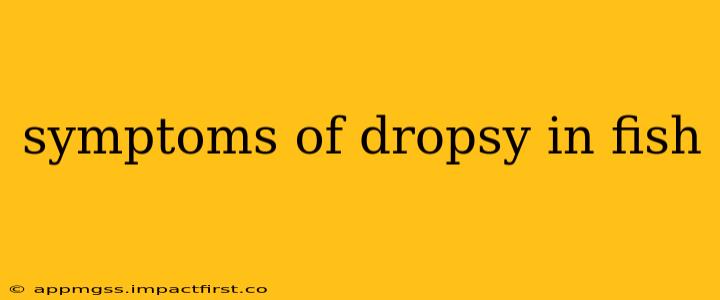Dropsy in fish is a devastating and often fatal disease. Characterized by a swollen abdomen, it's crucial for fish keepers to understand its symptoms to act quickly. This comprehensive guide will detail the symptoms, causes, and what to do if you suspect your fish has dropsy.
What are the Main Symptoms of Dropsy in Fish?
The most prominent symptom of dropsy is a swollen, distended abdomen. This is usually accompanied by other noticeable signs:
- Pineconing: Scales protrude outwards, giving the fish a "pinecone" appearance. This is because fluid builds up under the scales, forcing them to raise.
- Lethargy and Loss of Appetite: Infected fish become lethargic, showing little interest in swimming or feeding.
- Redness or Discoloration: The fish's body may exhibit unusual redness, particularly around the fins and belly.
- Protruding Eyes (Exophthalmia): In advanced stages, the eyes may bulge outwards.
- Frayed or Clamped Fins: The fins may appear frayed, torn, or clamped against the body.
- Difficulty Swimming: The swollen belly impairs movement, making swimming difficult.
- Bloody or Stringy Waste: The fish may produce bloody or stringy waste due to organ damage.
What Causes Dropsy in Fish?
Dropsy isn't a disease in itself, but rather a symptom of an underlying bacterial, parasitic, or viral infection. The infection causes fluid retention in the fish's body cavity, leading to the characteristic swollen abdomen. Common culprits include:
- Bacterial Infections: Aeromonas, Pseudomonas, and Edwardsiella tarda are some of the bacterial pathogens frequently associated with dropsy.
- Parasitic Infections: Certain parasites can weaken the fish's immune system, making it susceptible to secondary bacterial infections that cause dropsy.
- Kidney Failure: Damage to the kidneys can impair their ability to regulate fluid balance, resulting in dropsy.
- Poor Water Quality: Poor water conditions, such as high ammonia or nitrite levels, stress the fish and compromise their immune system, increasing vulnerability to infections that can lead to dropsy.
Is Dropsy Contagious?
Yes, the underlying infections that cause dropsy are often contagious. It's vital to isolate any affected fish immediately to prevent the spread of the disease to other tank mates. Thorough tank cleaning and disinfection are crucial after removing the affected fish.
How is Dropsy Diagnosed?
Diagnosing dropsy definitively requires a veterinary examination. While the visual symptoms are highly indicative, other conditions can mimic dropsy. A veterinarian can perform tests to identify the underlying infection and recommend appropriate treatment.
Can Dropsy Be Treated?
Unfortunately, dropsy has a high mortality rate. Treatment is challenging and often unsuccessful once the symptoms are advanced. Early intervention is key. Treatment may involve antibiotics, antiparasitics, and supportive care to improve water quality and reduce stress. However, the prognosis is often poor if the disease progresses to the point of pineconing.
How Can I Prevent Dropsy in My Fish?
Prevention is far better than cure. These steps can significantly reduce the risk of dropsy:
- Maintain excellent water quality: Regular water changes, proper filtration, and appropriate tank maintenance are essential.
- Quarantine new fish: Always quarantine new fish for several weeks before introducing them to your main tank.
- Feed a balanced diet: Provide a nutritious and varied diet to support your fish's immune system.
- Avoid overcrowding: Overcrowding increases stress and the risk of disease transmission.
- Manage stress: Avoid sudden temperature changes or other stressors that can compromise your fish's immune system.
By understanding the symptoms, causes, and prevention strategies, you can protect your fish from this devastating disease. Remember, early detection and prompt action are vital for increasing the chances of a positive outcome. If you suspect your fish has dropsy, consult an aquatic veterinarian immediately.
